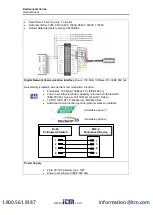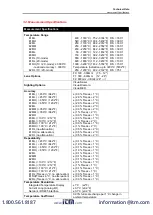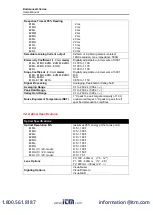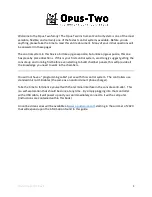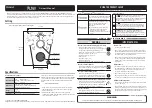
Description
Theory of Operation for Ratio (2-Color) Sensors
5
2.1. Theory of Operation for Ratio (2-Color) Sensors
The 2-Color ratio technology allows accurate and repeatable temperature measurements,
which don’t depend on absolute radiated energy values. In use, a 2-Color sensor determines
temperature from the ratio of the radiated energies in two separate wavelength bands (colors).
The benefits of 2-Color sensors are that accurate measurements can be made under the
following conditions:
•
When the field of view to the target is partially blocked or obscured.
•
When the target is smaller than the sensor’s field of view.
•
When the target emissivity is low or changing by the same factor in both wavelength
bands.
Another benefit is that 2-Color sensors measure closer to the highest temperature within the
measured spot (spatial peak picking) instead of an average temperature. A 2-Color sensor can
be mounted farther away, even if the target does not fill the resulting spot size. The convenience
is that you are not forced to install the sensor at some specific distance based upon target size
and the sensor’s optical resolution.
2.1.1. Partially Obscured Targets
The radiated energy from a target is, in most cases, equally reduced when objects or
atmospheric materials block some portion of the optical field of view. It follows that the ratio of
the energies is unaffected, and thus the measured temperatures remain accurate. A 2-Color
sensor is better than a 1-Color sensor in the following conditions:
•
Sighting paths are partially blocked (either intermittently or permanently).
•
Dirt, smoke, or steam is in the atmosphere between the sensor and target.
•
Measurements are made through items or areas that reduce emitted energy, such as
grills, screens, small openings, or channels.
•
Measurements are made through a viewing window that has unpredictable and
changing infrared transmission due to accumulating dirt and/or moisture on the window
surface.
•
The sensor itself is subject to dirt and/or moisture accumulating on the lens surface.
1-Color sensors see polluted atmosphere and dirty windows and lenses as
a reduction in energy and give much lower than actual temperature
readings!
2.1.2. Targets Smaller Than Field of View
When a target is not large enough to fill the field of view, or if the target is moving within the
field of view, radiated energies are equally reduced, but the ratio of the energies is unaffected
and measured temperatures remain accurate. This remains true as long as the background
temperature is much lower than the target’s. The following examples show where 2-Color
sensors can be used when targets are smaller than the field of view:
•
Measuring wire or rod
— often too narrow for field of view or moving or vibrating
unpredictably. It is much easier to obtain accurate results because sighting is less
critical with two-color sensors.
•
Measuring molten glass streams
— often narrow and difficult to sight consistently with
single-wavelength sensors.
2.1.3. Emissivity and 1-Color (single wavelength) measurements
Emissivity is a calculated ratio of infrared energy emitted by an object to the energy emitted by
a blackbody at the same temperature (a perfect radiator has an emissivity of 1.00). The
emissivity is preset at 1.00. For information on determining an unknown emissivity, and for
sample emissivities, refer to the appendix of this manual.
www.
.com
information@itm.com
1.800.561.8187



















